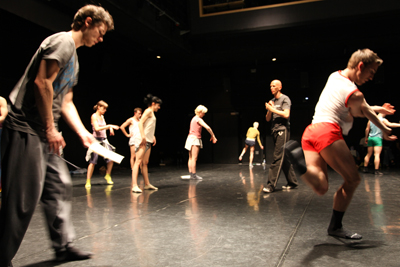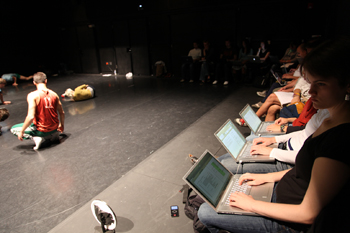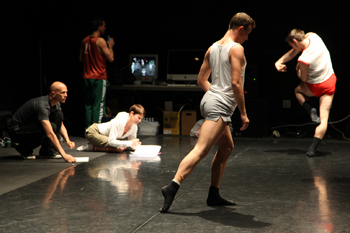Present at the Creation: Dancers, Cognitive Scientists Collaborate at UC San Diego
San Diego, Feb. 23, 2009 -- British dance sensation and choreographer Wayne McGregor and 11 stars from his Random Dance company were in residence at the University of California, San Diego for most of February. They were creating a new modern-dance work, and in a unique, interdisciplinary partnership, their every move in rehearsal was documented by UC San Diego cognitive science professor David Kirsh, students from two classes he created to study cognition and the arts – and a battery of high-definition video cameras.
|
"The research has been delivering results from the first day," says Kirsh. "One major area focuses on instructions: what sort of tasks does Wayne give the dancers? Which ones work and how? How does he work with the creative results of each dancer and modify it, morphing it in the direction that fits his larger conception. How are the dancers used as things to think with? What is the nature of choreographic thinking? How does distributed problem solving work in this sort of domain? We have learned something already in each of these areas."
"Interdisciplinary work can take hold at UCSD if you find an in-depth project that reflects the kind of university we are," says Martin Wollesen, director of the University Events program, ArtPower!, who invited McGregor to participate in a new Innovator-in-Residence program. "It requires that the visitor be both innovative in the artistic field and also interested in the future of scientific research. Wayne McGregor, for example, had an interest in the field of ataxia, the study of the inability to control one's muscles. At the same time he is recognized as one of the globe's leading choreographers, greatly respected in the world of modern dance."
McGregor and his dancers spent two weeks rehearsing in Mandeville Hall, and one week in the black-box performance space of the California Institute for Telecommunications and Information Technology (Calit2). At both venues, Kirsh's team deployed nearly a dozen high-definition cameras to capture all of the action, all day every day, for three weeks.
|
McGregor has collaborated previously with scientists, but never as extensively as at UC San Diego. Ultimately, he hopes that science will help him create greater works of art. "I have a relationship with the dancers, where they have to provide answers, body images, and that is my focus," says McGregor, who is also the resident choreographer at London's Royal Opera. "David is starting to help us understand this process. I am interested in the specificity of how they build an image. Is it controllable? We are able to respond to some of the articulations between me and the dancers. They are extending my ability to work with the body. What is the direct connection between what they are thinking about movement construction and how they produce?"
"We know we have had an impact on the choreographer and the dancers because in our frequent debriefings, we have learned that he believes we have substantially improved his delivery of instructions and challenged him to reinterpret the sense of his work," explains Kirsh. "Because we have had dozens of hours discussing the nature, variety and role of imagery in instructions, he has become more precise in his instructions, and more open to protracted discussions on the meaning of those instructions with his dancers. They feel they can now ask him for deeper clarification or help on interpretation. He has begun distinguishing more modalities of imagery - body feeling, acoustic, emotional feeling, even gustatory. He now discusses the difference between the vividness and controllability of imagery, a classic distinction in the psychological literature."
|
Interdisciplinary collaboration is a hallmark of education and research at UC San Diego, where musicians work closely with computer scientists, philosophers collaborate with neuroscientists and, in this program, performing artists have their work enhanced by those who study the intricate details of human cognition. Students are also required to get real-world experience. "If we can establish relationships between the student and outside influences that have a dynamic practical effect, then we are underway," says Gabriele Wienhausen, former provost of Sixth Colleage. "We did this with the brilliant choreographer Wayne McGregor, who shared this vision, when he was first on campus in 2007. Working with Marty Wollesen we set up a Wayne McGregor Workshop, where he talked about his profession and what it means to be creative and how you can begin to understand yourself."
According to cognitive scientist Kirsh, being present at the creation of a new dance work can provide discoveries and insights of broad value beyond the domain of dance. "For instance, instructions are of universal concern, whether they be instructions to workers in factories, instructions to home cooks presented in the form of recipes, instructions for furniture assembly, or classroom instructions in labs, exams and so on," says Kirsh. "Choreographers use more modalities than most people. They gesture continuously, they speak of course, they use musical or phonetic sounds 'woooo-aahhh-ka-daaah.' They even push and pull on bodies. There has been little study of how these different modalities figure in getting people to do the right thing."
"Another thing we have been learning is how memory can be distributed across a team. The choreographer assigns names to exercises and dance phrases, but doesn't bother to memorize all the solutions and partial solutions the dancers produce. He requests their solutions in the future and then counts on them to recall them. It turns out that individual people have memory for different aspects of a phrase: one remembers its kinetics, another its emotionality or its dynamics, a third remembers precise details of where the fingers were placed on another body. The team as a whole recovers the phrase."
|
For his part, McGregor is constantly seeking new ways of observing his dancers, and while he was in residence at Calit2, he spent time with the technologists working on some of the most advanced visualization facilities in the world. The Varrier display allows a single viewer to sit in front of a 100-million-pixel, semi-circular display wall and interact with animations in three dimensions - without having to wear 3D glasses. Specifically, McGregor was able to do a "flythrough" of a 3D model of the human body at full size - a technology that could one day become useful as a method for displaying a dancer's movements.
Kirsh and McGregor also visited the HIPerSpace wall, Calit2's 287-million-pixel tiled display wall (the second-highest resolution display in the world), allowing a roomful of viewers to navigate quickly from images of an entire city down to one individual on one street, because the original image displayed on the wall is so large. The technology could one day allow the choreographer to look at images of his entire dance company, but zero in to see how a particular muscle in a dancer's arm changes in a single movement.
The work begun at UC San Diego in February will result in the world premiere of an as-yet-unnamed dance work to be performed at Sadler's Wells Theatre in London next fall.
Related Links
Random Dance
David Kirsh Website
Media Contacts
Barry Jagoda, bjagoda@ucsd.edu




